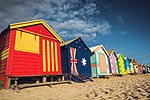HMVS Cerberus (Her Majesty's Victorian Ship) is a breastwork monitor that served in the Victoria Naval Forces, the Commonwealth Naval Forces (CNF), and the Royal Australian Navy (RAN) between 1871 and 1924.
Built in Jarrow, UK, at Palmers Shipbuilding and Iron Company for the colony of Victoria, Australia, under the supervision of Charles Pasley, Cerberus was completed in 1870, and arrived in Port Phillip, the port of Melbourne on the SW coast of Australia in 1871, where she spent the rest of her career. The monitor was absorbed into the CNF following Federation in 1901, and was renamed HMAS Cerberus when the navy became the RAN in 1911. By World War I, Cerberus' weapons and boilers were inoperable; the ship served as a guardship and munitions store, while carrying the personnel of the fledgling Royal Australian Naval College on her paybooks. In 1921, the ship was renamed HMAS Platypus II, and tasked as a submarine tender for the RAN's six J-class submarines. "H.M.A.S. Cerberus, the ship that for many years has been anchored at the mouth of the Yarra serving as a training ship, was towed to Geelong to-day. Under the name Platypus she will now serve as a depot ship and submarine base. The Cerberus entered Hobson’s Bay on April 9, 1871, and was then the most modern ironclad afloat, representing the last word in naval architecture; she was certainly at that, time the most powerful vessel in the southern seas. She was built to the order of the Victorian Government, whose navy then consisted of the frigates Victoria and Nelson. In recognition of the part played by Victoria in the New Zealand war, the Imperial government granted £100,000 to the new State toward the cost of a modern warship. The voyage of the Cerberus to Australia occupied five months, and fears were entertained that she would founder. She rolled to forty degrees, and her out-of-water weight was 1,900 tons as compared with an under-water weight of 1,800 tons. The Victorian flag was hoisted on the ship at Port Said on December in. 1870. The Cerberus remained at the Yarra mouth so long that special derricks had to be used to lift her anchors." 1921, A Page of History, Famous Ship Leaves Her Old Moorings.
In 1924, the monitor was sold for scrap, and was sunk as a breakwater off Half Moon Bay. The wreck became a popular site for scuba diving and picnics over the years, but there was a structural collapse in 1993. There have been several campaigns to preserve the ship (one of which is ongoing), as she is one of the last monitors, the only surviving ship of the Australian colonial navies, and one of only two surviving ships in the world with Coles turrets.











